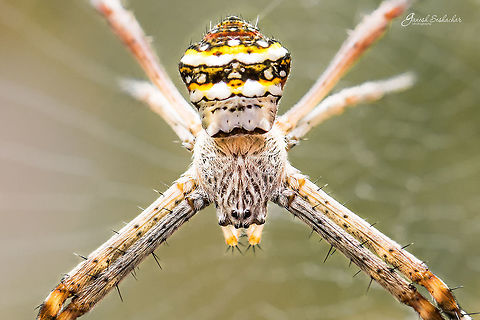 Promoted
Promoted
Indian Argiope Spider
The Indian Argiope Spider, scientifically known as Argiope anasuja, is a species of orb-weaving spider found in India and other parts of South Asia. These spiders are known for their striking appearance, with a large, colorful abdomen marked with distinctive patterns, often resembling a cross or a letter 'Z'. The rest of their body is typically black or brown.
Indian Argiope Spiders are known for building intricate, symmetrical orb-shaped webs, which they use to capture flying insects. They are not dangerous to humans and are beneficial in controlling insect populations. These spiders are typically found in gardens, fields, and other open areas with plenty of flying prey.
The female is larger than the male and remains in the center of the web, while the smaller male resides on the periphery. Mating can be a risky endeavor for the male, as he may risk becoming a meal for the female afterward. These spiders are fascinating creatures, known for their web-building skills and distinctive appearance.
Certainly, here are more details about the Indian Argiope Spider:
1. **Scientific Name**: Argiope anasuja.
2. **Appearance**:
- Females are larger than males, with a body length of around 10-15 mm, while males are about 4-6 mm.
- They have a large, colorful abdomen with intricate patterns, often resembling a cross or 'Z'. The rest of their body is typically black or brown.
- Their legs are long and slender, with distinct yellow bands.
3. **Habitat**: Found in various parts of India and other South Asian countries, often in gardens, fields, and open areas.
4. **Web Construction**: Indian Argiope Spiders are skilled orb-weavers, constructing large, circular webs that are often between plants or in tall grass. These webs are used to catch flying insects.
5. **Diet**: They primarily feed on insects that get trapped in their webs, including flies, moths, and other small flying creatures.
6. **Behavior**:
- Females tend to stay in the center of their web, while males stay on the periphery.
- Mating can be a risky endeavor for the male, as there is a chance that the female may cannibalize him after mating.
7. **Venom**: Indian Argiope Spiders are not considered dangerous to humans. Their venom is primarily used to immobilize prey, not for defense.
8. **Reproduction**: After mating, the female lays her eggs in a silken egg sac, which she guards until the spiderlings hatch.
9. **Lifespan**: The lifespan of an Indian Argiope Spider can vary, with females generally living longer than males. Females may live for several months, while males have a shorter lifespan.
10. **Role in Ecosystem**: These spiders play a vital role in controlling insect populations, helping to maintain ecological balance by preying on flying insects.
Indian Argiope Spiders are fascinating creatures known for their intricate webs and striking appearance. They are a common sight in many parts of India and contribute to the natural pest control in their habitats.
The Indian Argiope spider, scientifically known as Argiope anasuja, is a species of orb-weaving spider found in India and other parts of South Asia. Here are some key characteristics and facts about this spider:
1. Appearance: Indian Argiope spiders are known for their striking appearance. They have a large, colorful abdomen with distinctive yellow and black markings that resemble a face. The body is usually silver or gray.
2. Size: These spiders are relatively large, with females typically measuring around 15-20 mm in body length, while males are smaller, averaging 5-6 mm.
3. Web: Like other orb-weaving spiders, Indian Argiope spiders construct intricate, circular webs to catch flying insects. These webs are usually positioned horizontally, often in open areas like gardens.
4. Diet: They primarily feed on insects that get caught in their webs, including flies, bees, and other small prey.
5. Behavior: Indian Argiope spiders are not aggressive towards humans and are generally harmless. They are more inclined to retreat than bite when disturbed. Their primary focus is on catching prey for sustenance.
6. Reproduction: After mating, female Argiope spiders produce large, round egg sacs that contain hundreds of eggs. These sacs are typically suspended within their webs.
7. Habitat: You can find Indian Argiope spiders in a variety of habitats, including gardens, grasslands, and forested areas, across India and neighboring countries.
8. Seasonal Presence: They are often seen during the monsoon season when insect activity is high, and their webs are more likely to capture prey.
9. Importance: These spiders play a role in controlling insect populations and maintaining ecological balance in their habitats.
Remember that while Indian Argiope spiders are not considered dangerous to humans, it's always a good practice to avoid disturbing or handling them to prevent accidental bites or damage to their webs.

Argiope anasuja or Signature Spider is a species of Orb spider found in Asia ranging from Pakistan to the Maldives. Like other species of the same genus, it builds a web with a zig-zag stabilimentum.

comments (1)